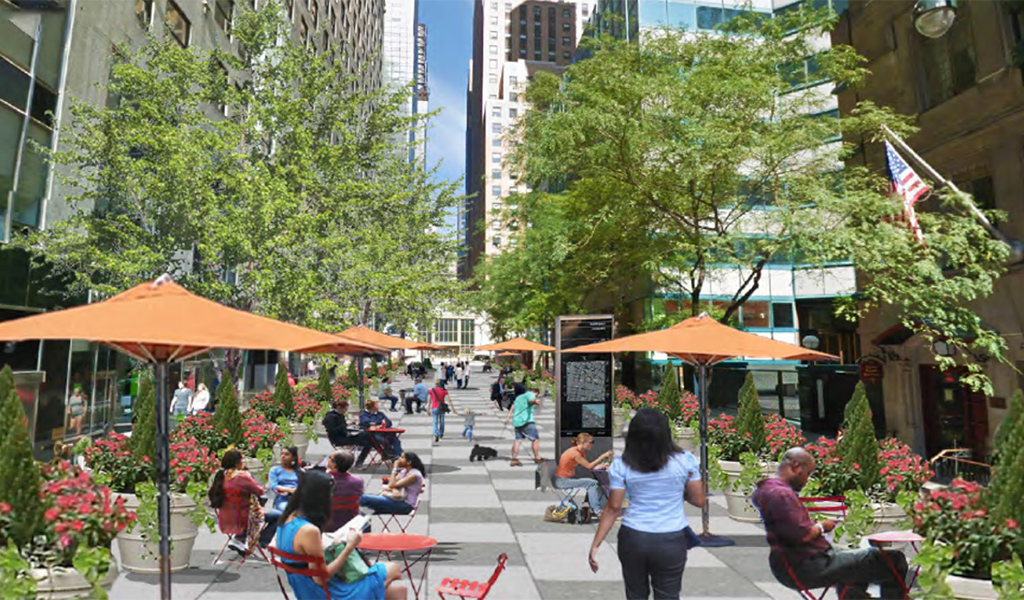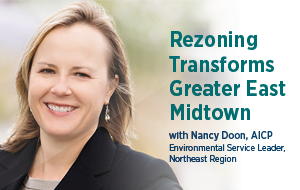Cities are currently experiencing a surge in population and economic growth. Private-sector investment, a renewed public interest in urban living, a younger and more active workforce, and a shift in market trends due to e-commerce are creating new opportunities and challenges for city planners. In response, cities are re-examining their zoning codes to manage density, commerce, and public space.
In an attempt to meet these demands, cities have constructed new housing, improved public transit, implemented community benefits like bicycle and pedestrian enhancements, and upgraded parks and public space. Taken independently, however, these solutions cannot address all of today’s concerns. When such changes create new challenges, cities and stakeholders need to take a more comprehensive approach to planning.
Conflicting interests, political influences, and public opinion all have the potential to drive or stall rezoning efforts—especially in dense urban areas, where rezoning can be especially complicated. But cities are also where zoning can be used to stimulate economic development that results in high-quality improvements with significant benefits—including upgrades to transportation infrastructure, enhancements to the public realm, creation of a diverse and affordable housing stock, and preservation of historic resources. Comprehensive rezoning initiatives can provide incentives to meet economic development objectives, such as job creation and increased tax revenue, in addition to promoting a vibrant and growing economy.
Improving Transportation for All Modes
In cities with multimodal transportation options and major transit hubs, rezoning can help provide mechanisms for necessary upgrades to transportation infrastructure. For instance, zoning codes could be modified to require that development on sites in designated transit improvement districts include pre-identified transit improvements in exchange for increases to floor area. Transit improvements could include creation of plazas and enhancements to stairways, escalators, station entrances, and bicycle parking; such upgrades help decrease congestion and improve pedestrian circulation, wayfinding, and safety. Encouraging developments in transit zones reduces the number of cars that would need to access sites and fosters a mindset in which the use of public transit is encouraged.
A rezoning initiative can spur employers to subsidize employee transit travel or offer other incentives to minimize the use of private vehicles. The use of shared parking is a simple example of the power of rezoning to potentially limit the number of spaces required for a certain land use within a development. This allows multiple facility types to share the available parking, since the uses would not peak at the same time. For example, an office use and a destination retail use on the same site could share weekend parking. At its most basic level, a rezoning initiative has the potential to provide land use and transportation planning lawmakers with a tool that considers policy, operation, and investment within a demand-managed multimodal environment.
Preserving History while Creating the Future
Historic preservation can offer cultural, aesthetic, economic, and educational benefits to a community. Rezoning creates an opportunity to examine the cultural and historical aspects that make neighborhoods unique. Often seen as being at odds with new development, historic preservation can play an important role by providing landmark protections to buildings that have significant architectural or historic value. It can also encourage economic growth. In addition to maintaining character-defining features meaningful to residents, the rezoning process can take advantage of state and federal historic rehabilitation tax credits to transform underutilized buildings and neighborhoods into vibrant communities.
When historic preservation is the goal, significant modifications to existing buildings are often undesirable. Rezoning can permit the sale of unused air rights for landmarked properties. This lessens the financial burden landmarking can have on property owners, which reduces opposition to historic property regulation and provides funds for the maintenance of these buildings.

Enhancing the Public Realm and Creating Connections
Within a major business district, rezoning can also help improve both pedestrian and vehicular circulation on street networks. Zoning can be established that requires any development above a certain threshold to contribute to a public realm improvement fund in exchange for increases to floor area. This fund can be used to implement enhancements in the form of parks, plazas, and shared streets; pedestrian crosswalks; wider sidewalks and medians; curb extensions; and dedicated turn lanes. These enhancements can create community connections that make neighborhoods more accessible for everyone.
In cities with significant historic resources, zoning can be established to require that a portion of the sale of unused air right from historic properties go into the public realm improvement fund. Zoning would need to be flexible in terms of where historic properties could transfer and sell their unused air rights. The ability to transfer these rights to other sites within the zoning district would make it easier to preserve historic buildings and maintain a city’s distinctive built environment.
Promoting Equality and Diversity through Affordable Housing
For many, the primary purpose of zoning regulation is to partition uses that are considered incompatible. Without careful consideration, it can effectively exclude families with children, disabled people, low-income residents, and certain racial groups. However, numerous rezoning techniques can be used to promote equality, affordability, and diversity in housing and land use. Such techniques include:
Inclusionary Zoning
Typically applied to residential districts, inclusionary zoning mandates or incentivizes developers to set aside a certain percentage of units for housing below the market rate.
Overlay and Floating Zones
These are used to promote a specific type of development, provided certain conditions are met. Typically, they’re found either in environmentally sensitive areas or those with historical significance. For example, they can be used to promote multi-family development in single-family districts, with the requirement that the development include affordable and/or senior housing.
Mixed-Use Zoning
In historically suburban areas, mixed-use zoning creates opportunities for affordable apartments by allowing residential uses within commercial districts, such as shopping plazas and office parks.
Accessory Apartments
Rezoning can also permit the use of accessory apartments, which allow homeowners to build a separate, independent apartment on a property already occupied by a single-family home.
Special-Use Permits
These allow for land use that is not in the zoning district to be permitted, subject to requirements set forth by the community.
How Can VHB Help
Rezoning has the power to affect enormous change, and VHB is passionate about creating meaningful contributions for our communities through the work we do. While change often breeds challenges, it also leads to opportunity—to reshape neighborhoods, spur economic development, and provide infrastructure improvements that benefit all. While city needs have changed over the years, our goal hasn’t. We continue to assist our client partners in delivering projects as efficiently and effectively as possible. To learn more about the benefits of rezoning, contact Nancy Doon.




